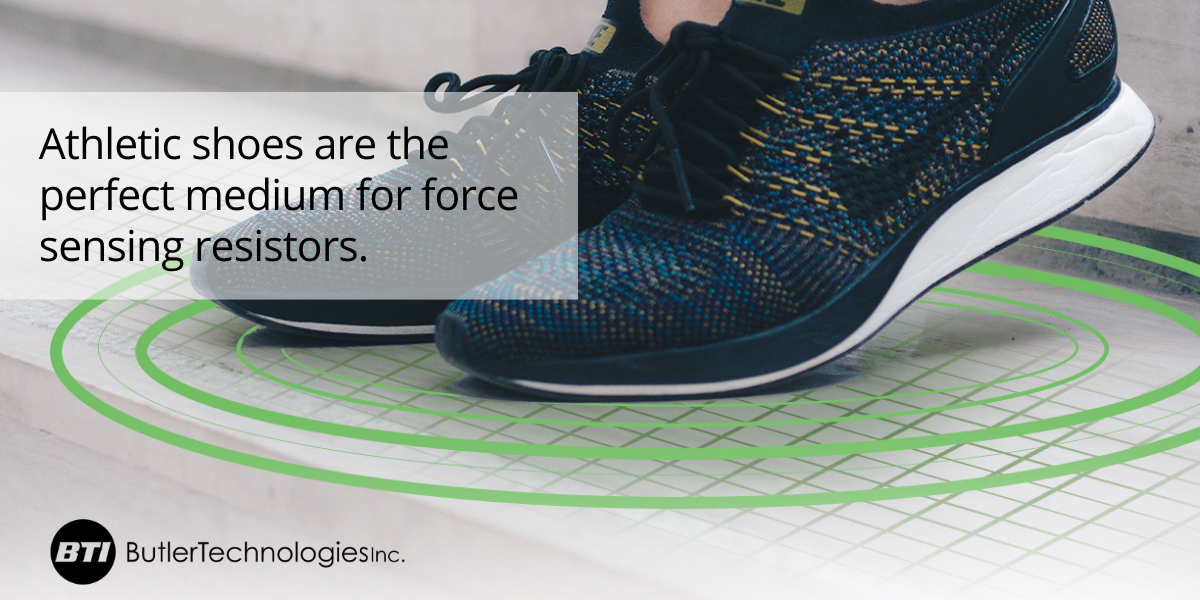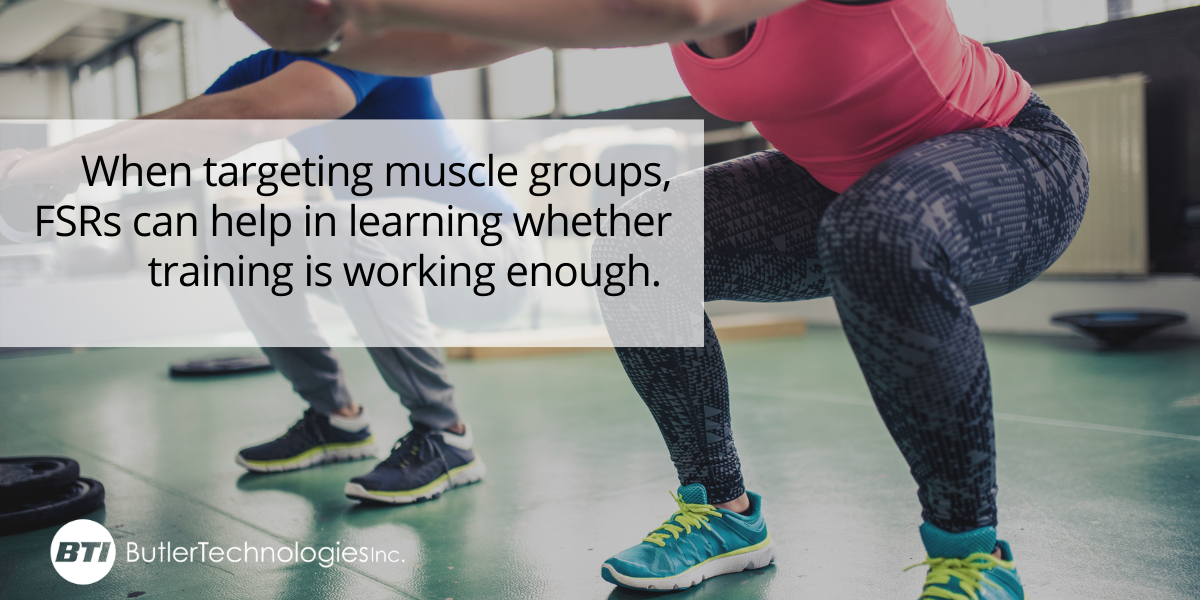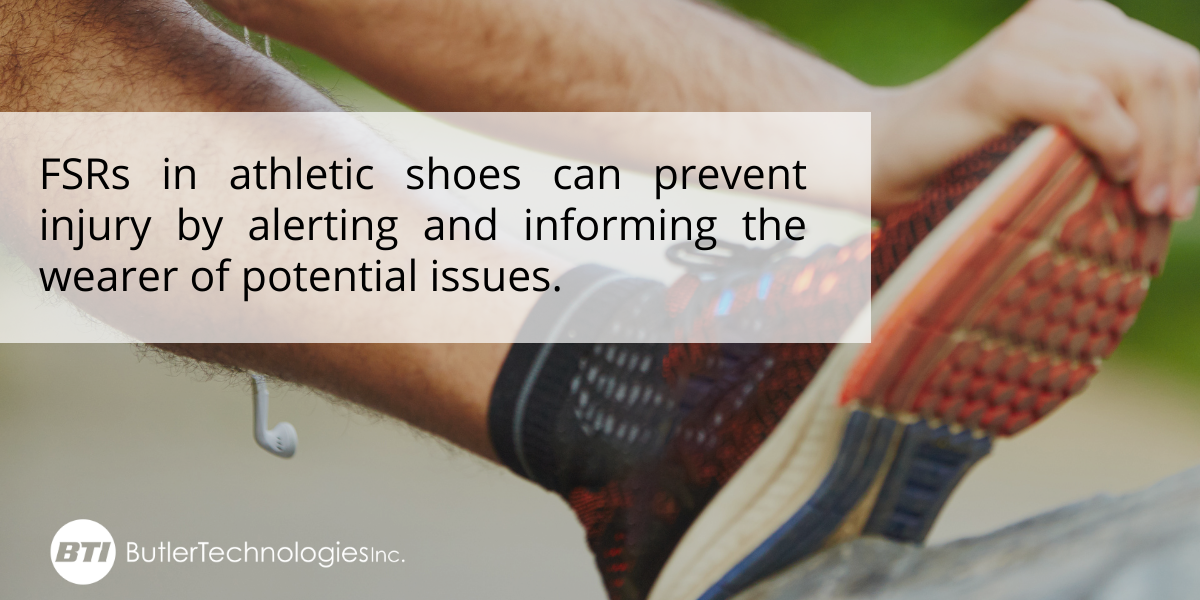Athletes, gymgoers, and runners alike have a plethora of accessories. But ask any of them what impacts their form, ability, and comfort the most – and they’ll tell you it’s their shoes.
Shoes make an enormous impact on exercise and training. Comfort is often the first example that comes to mind for the average person – but shoes also affect form, speed, balance, and injury prevention, especially for athletes who make a career out of being on their feet.
Form, balance, and speed are all things athletes focus on and make a conscious effort to improve over time. However, someone’s training is only as good as the data they have available to inform them on how they’re doing and how they can improve.
What if an athletic shoe could inform the wearer of data captured from the shoe during exercise? What if, as a runner starts their morning jog, they could keep an eye on their stance, form, speed, and other factors?
Force sensing resistors can help do just that.
A force sensing resistor, also known as force sensitive resistors or force sensors (or FSRs for short), is a variable resistor that senses—you guessed it—force applied to it. An FSR is made up of multiple thin layers of high-resistance, carbon-based inks that can measure the varying levels of resistance when pressure is applied and released. The measurement can then be relayed to selected output electronics to be used for countless applications in different fields.
Force is always being applied to the feet when running, walking, or playing intensive sports. It only makes sense that force sensing resistors can help capture data about that force and help athletes improve over time without any changes in their outfit. Athletic shoes are the perfect medium for force sensing resistors.
Four Ways Force Sensing Resistors Can Improve Athletic Performance
1. Form
A runner’s form can be tracked through FSRs in running shoes to let the wearer know if they’re hitting the ground in an optimal way. If they have a goal for improving a particular part of their form—such as making sure to land on the ball of their foot to not have their heel absorb all the shock upon impact with the road—they can make changes after checking the data on their run to improve their form over time.Runners and athletes can see how their form changes throughout the duration of their exercise, too. For example, if the FSR’s data was shared with the athlete’s smartphone or smartwatch, the wearer could check their form at the beginning, middle, and end of their workout. Their form may very well change over time, from overuse of certain muscles or exhaustion.
They can also check on their balance by comparing the data from one foot to the other.Stride can also be measured over time and compared with form data to determine if the wearer’s form changes when going faster or taking larger steps.
2. Targeting Muscle Groups
We all know different shoes are ideal for different types of exercise. In order to target or assist certain muscle groups, different shoe types are sometimes necessary.
However, especially when targeting different muscles in the legs, force sensing resistors could be a big help in . If you’re training your upper or lower leg muscles, correct form may mean that your heels should be down flat on the floor. If that’s not being indicated in your FSR data, maybe you’re not working the ideal muscles as well as you could be.
3. Finding the Right Shoe
Finding the right shoe matters greatly. Everyone’s feet are different, and without proper fitting shoes for the type of exercise performed, foot, back and knee pain can quickly become a problem. If the shoes don’t have the correct arch support, for example, people may unknowingly overcorrect and use different muscles to avoid discomfort. Over time, this can throw off your form and lead to even more pain.
While shoe stores do their best to determine what you need depending on your foot type and arch height, it’s all too common to leave with a shoe that feels great initially but leads to discomfort down the line. A runner may be halfway through their morning trail when an inkling of regret comes to them – only to be followed up by blisters in places you weren’t expecting.
Force sensing resistors in inserts for shoe soles could help prevent this problem for next time. If athletes aren’t fully convinced their shoe is the best one for the job, they could wear an FSR insole and gather data on how their feet are hitting different points in their shoes. Once they’ve determined the issue – whether it’s a lack of arch support, too low of a heel, or something else entirely, they can make a more confident purchase next time.
The Dr. Scholl’s® Custom Fit® Kiosk is one application already on the market that offers consumers a way to find their “footmap” and know the optimal shoe type for their foot. With force sensing resistors in shoes, applications like this kiosk could come with consumers wherever they go without seeking out a kiosk.
4. Injury Prevention
Force sensing resistors in shoes could inform the wearer if they’ve been standing for too long or if their joints may need a break on a long run. A connected device could send a gentle reminder to sit down for a bit, do some stretches, or take it easier tomorrow.
FSRs in shoe soles could also help improve balance over time by letting the wearer know if they’re putting weight on one foot more than the other. Or, during the cooldown window, they could determine if certain stretches are being done correctly by tracking if specific pressure points are being pressed in different areas of the shoe.
Choosing the Right Force Sensing Resistor for your Footwear Application
Force Sensor Design Constructions
There are several different types of designs for force sensing resistors. The various patterns can impact the sensitivity levels of the FSR.
- Force Sensing Resistors can be designed as single-zone FSRs, Matrix Arrays, Discrete Arrays, Resistive XYZ (Digitizer) Pads, and Linear Potentiometers.
- Single-zone FSRs have one sensing location with 2 traces.
- Matrix Arrays use multiple sensing locations connected to rows and columns – like a matrix.
- Discrete Arrays are a collection of any number of single-zone designs combined together in one design. The leads can go out to the connector individually or connected together first.
- Resistive XYZ Pads, or Digitizer Pads, have a single input and force measurement, such as a finger or a stylus. These are very similar to touch screens.
- Linear Potentiometers sense force on a single axis, along with the force applied, and measurements can be read on a sliding scale.
Depending on the purpose of your specific shoe or insole, one of the above types may work better than others – or, you could combine multiple forms of force sensing resistors in one shoe.
Most commonly, you’ll find matrix arrays and discrete arrays used in applications like footwear – but the possibilities are endless.
ShuntMode vs. ThruMode
In addition to the different design constructions, there are also two different types of force sensing resistor configurations: ShuntMode and ThruMode.
ShuntMode FSRs consist of printed silver interdigitated fingers that are (“shunted”) by an FSR carbon layer. As force is applied on either end, the semiconductive FSR element on the top layer connects with the conductive traces on the bottom layer, and the circuit is closed to form an electric current which can be measured through an output device.ShuntMode force sensing resistors are receptive to a wide range of levels of pressure, so they can accommodate a plethora of different applications. The electrodes used in the design are capable of being designed in a multitude of different configurations, as well.
ThruMode force sensing resistors also use two main layers of substrate, but they function differently. The ThruMode’s substrates don’t use interdigitated fingers of silver ink. Rather, when the two substrate layers are sealed together, the FSR element is placed onto the solid conductive area, and fully covers the conductor. Because of this, ThruMode FSRs are more receptive to lighter forces, as pressing anywhere at virtually any level of pressure will set off the sensor.

However, the detail offered by a ThruMode FSR likely isn’t required in a footwear application where the force applied is great. They also require more silver and carbon ink, and more steps during the printing process, thus making them more costly than the ShuntMode FSR.
For these reasons, ShuntMode FSRs are likely the best type for a footwear application.
Materials
Materials used can vary on the specifics of the application. Silvers, carbon, and blends, or copper are all conductive ink options for applying to a printed circuit board (or PCB). However, the use of silver is the most common material for Shunt Mode FSRs.
Experts in Force Sensing Resistors
Are you looking to incorporate force sensing resistors into your next footwear or athletic apparel project? With 30 years in the industry and an expert design team that can take your product from concept to production, Butler Technologies, Inc. would be happy to help. Reach out about your next project today.
Meet the Author
 Madelyn is an integrated marketing specialist at Butler Technologies and has a passion for problem-solving, project management, and storytelling. She loves marketing in the B2B technology space and has a degree in English specializing in editing, writing and media from Florida State University.
Madelyn is an integrated marketing specialist at Butler Technologies and has a passion for problem-solving, project management, and storytelling. She loves marketing in the B2B technology space and has a degree in English specializing in editing, writing and media from Florida State University.
